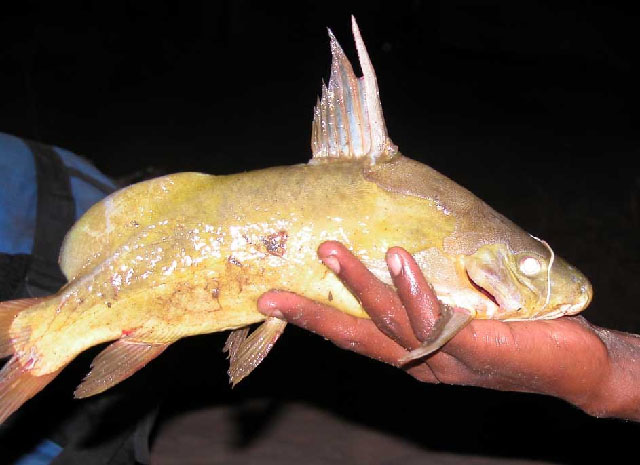| Mochokidae (Squeakers or upside-down catfishes) |
| 37 cm SL (male/unsexed); max.weight: 500.0 g; max. reported age: 12 years |
|
benthopelagic; pH range: 6 - 8; dH range: 30, potamodromous |
| Africa: Nile basin, Abaia, Stephanie, Rudolf Lake, Tana?, Uebi Guiba (Uebi Shebeli)(Ref. 3202). In West Africa found practically in all basins (except for the coastal basins of Guinea, Sierra Leone and Liberia), including the Senegal, Gambia, Niger, Volta and Chad basins (Ref. 57223). |
|
Dorsal spines (total): 1; Anal spines: -0. Diagnosis: gill slits not extending ventrally beyond pectoral-fin insertions; post-orbital length at least 60% of snout length; maxillary barbels longer than head but not reaching to pelvic fins, unbranched and without tubercles or distinct basal membrane; outer mandibular barbels with few, rather short and simple ramifications; branches of inner mandibular barbels few, short, simple and tuberculate, at least the anterior ones; mandibular teeth moderately developed, numbering 24-39; dorsal- and pectoral-fin spines straight; denticulations on pectoral-fin spines weaker on outer than on inner margin; dorsal-fin spine smooth anteriorly, except for a few apical denticles; however, large individuals may also have a weak denticulation on lower half of spine; humeral process pointed and granulose, slightly keeled ventrally; adipose fin well developed, high, rather close to rayed dorsal fin; maxillary barbels white or beige; outer margins of caudal-fin lobes more or less dark (Ref. 57223).
Coloration: ground colour variable from greenish-yellow to pale brown; ventral areas whitish or light yellow; some individuals have a pattern of very fine specks; fins more or less of the same colour as body; outer margins of caudal-fin lobes black-edged in some individuals; young specimens have a marbled and finely speckled pattern (Ref. 57223). |
| Maximum TL was recorded at 47.0 cm (Ref. 57223). Omnivore, feeds on insect nymph, larvae, eggs and detritus (Ref. 13868). Also feeds on fish, bivalves in the Sudd and snails in Gezira irrigation canals. Oviparous (Ref. 205). Breeding occurs during the flood season (Ref. 28714). Utilized for human consumption. |
|
(Ref. 96402)
|
| harmless |
|
Source and more info: www.fishbase.org. For personal, classroom, and other internal use only. Not for publication.
Page created by Jen, 05.08.02,
php script by kbanasihan 06/09/2010 ,
last modified by
dsantos, 20/08/10

